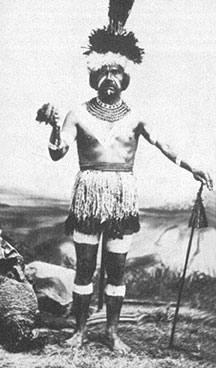Southcentral California
I. Southcentral California. (Penutian, etc) = language family
A. Includes Lake and Foothill Yokuts, Coastanoan (Penutian), Esselen (Hokan), Salinan (Hokan?).
1. Environment is rich and varied: riverine, foothill grasslands, lake, coastal. Valley Yokuts country is lake-slough-marsh.
a. Heavy, thick, fog and freezing temps. in winter, heat (to 120 F) and drought in the summer in the valley. Temps moderate along coast.
2. Heavy reliance on acorn, tule and other seeds clearly established.
3. Salinan people hit particularly hard by colonization and most dead or left within four generations. Some think they spoke a Hokan dialect.Last speaker believed to have died in 1958. Now have tribal recognition by State of California based on research of Mission records that shows origins in local villages.
B. Traditions are closely associated with the traditions of North central California.
C. Here is the largest area of homogenous culture.
1. Moderate diversity in terms of basketry, twinned and coiled, although twinning was clearly preferred.
D. Clam shell disc beads were clearly the gold standard. Few other treasures collected.
 1.
Shells broken into pieces, bored, strung, sanded smooth.
1.
Shells broken into pieces, bored, strung, sanded smooth.
a. Obtained raw materials from coastal peoples.
b. Value depended on size, thickness, age, and sheen, the more the better.
i. Some sheen acquired by human touch.
ii. Size ranged from
1/3” to 1” dia. and from 1/3” to ½” thick.
2. Treasures included things which could not be made to a specific enough scale to assure uniformity in value, but still had monetary value.
a. Longitudinally-perforated shell cylinders.
b. haliotis (abalone) was exported far from the main source in Monterey CA.
E. Arts and material culture.
1. Music and dance was infrequently casual in nature. Few group ceremonials. All performed out in the open.
a. Six-day long ceremony for the year’s dead involved burning a tule effigy and the burning of property.
b. Characteristic group ceremonial dress was hand crafted.
i. Shamans were typically males and wore finery.
ii. A short skirt of eagle-down twisted into milkweed string, adorned with hawk feathers.
iii. Tall (38cm) headdress of magpie feathers, surrounded by a base of crow feathers.
iv. Headnet covered with eaglette down.
v. Face painting representing their totems.
c. Six-day long Datura drinking ceremonies by choice of individual.
d. Instruments included cocoon rattle and clapper sticks.
i. Clapper sticks of elderberry limbs used for casual music making.
ii. Salinan said to have use a two stick rasp, not known as an instrument in remainder of CA.
2. Clothing, a Yokuts example.
a. Men’s clothing included a breechcloth of buckskin, but nudity was preferred.
In winter, rabbit-skin or mud-hen robes in winter.
i. Moccasins usually only worn away from home.
ii. Men seldom tattooed, but septum and ears pierced.
iii. Men went bare headed.
b. Women’s clothing consisted of front and back aprons of shredded tule, marsh grass, rabbit skins or mud-hen skins, falling to between ankle and knee. In winter a robe of rabbit skin or mud-hen.
i. Moccasins worn in dry weather when traveling.
ii. Women sometimes wore chin tattoos, frequently had septum and ears pierced.
iii. Women wore basket hats when transporting loads.
3. Tules and other fibers.
a. Lake Yokuts basketry was mostly twinned of tule.
i. Sifting baskets of tule foundation and string weft. Coiled baskets imported from FY until late 19th century.
b. The Foothill Yokuts made seven types of twinned and nine types of coiled baskets.
i. Used for food gathering and preparation, storage, traps and weirs, cradles, gambling trays, dance
accessories.
ii. Designs are mostly horizontal or banded. Large number of geometrics and many anthropomorphic forms.
iii. men made cradles, wood carrying baskets, portable traps, and weirs.
c. Tule boats, called "balsas" and tule rafts plied the lakes and the marshes of the San Joaquin Valley.
i. Carried up to six adults and their possessions.
d. Housing made of tule mats laid over two-post frame construction. Year-round occupation. Men hauled, women wove.
i. Some houses were single family dwellings some housed up to ten families, each with their won fire and door.
ii. In the foothills slabs of cedar or pine bark used. Thatching also known.
iii. Ramadas used extensively.
iv. Both steam and dry sweathouses were used.
e. Head rings for carrying made of tule.
f. String and cord made of wild milkweed fibers.
g. Duck decoys of tule.
4. Wood work. Most wood imported. Woodworking not too highly developed.
a. Dice were made from walnut shells filled with asphaltum and inset with abalone chips.
b. Fire drill.
c. Mush-paddles and a few bowls.
d. Bows are unbacked for waterfowl and sinew-backed juniper for big game. Strung with sinew.
e. All arrows fletched - wood-tipped cane for waterfowl hunting and stone-tipped hardwood arrows used for big game huting.
f. Spears used by FY for salmon fishing.
g. Wooden mortars, all imported.
i. planks cut to fit.
ii. planks are drilled throught he vertical dimension.
iii. ropes are threaded through the holes and tied taut.
iv. canoe is soaked to swell wood.
v. cracks between planks are pitched or asphalted.
5. Horn, skin, bone and shell.
a. Bone awls and scrapers.
b. Shell necklaces (removed during thunder storms).
c. The Foothill Yokuts made deer disguises worn by hunter.
d. Fish hooks.